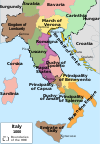
The Lombards or Longobards were a Germanic people who conquered most of the Italian Peninsula between 568 and 774.
The 680s decade ran from January 1, 680, to December 31, 689.
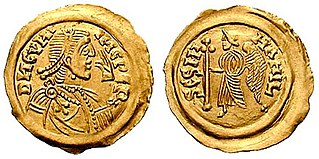
Year 688 (DCLXXXVIII) was a leap year starting on Wednesday of the Julian calendar. The denomination 688 for this year has been used since the early medieval period, when the Anno Domini calendar era became the prevalent method in Europe for naming years.

Rothari, of the house of Arodus, was king of the Lombards from 636 to 652; previously he had been duke of Brescia. He succeeded Arioald, who was an Arian like himself, and was one of the most energetic of Lombard kings. Fredegar relates that at the beginning of his reign he put to death many insubordinate nobles, and that in his efforts for peace he maintained very strict discipline.
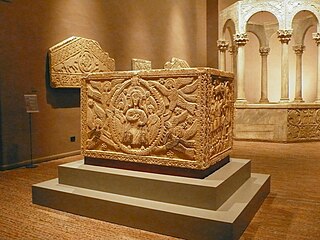
Ratchis was the Duke of Friuli (739–744) and then King of the Lombards (744–749).

The Battle of Coronate took place in 689, after King Cunicpert returned from exile and ousted Alahis, Usurper King and Duke of Trent, from the capital Pavia.
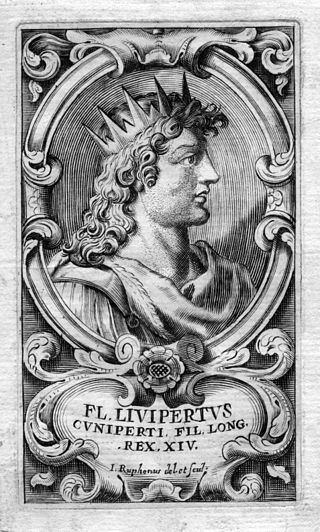
Liutpert was the Lombard king of Italy between 700 and 702, with interruption. Upon succeeding his father, King Cunincpert, at a young age, he ruled together with his tutor, Ansprand, the duke of Asti. After eight months, he was deposed by Raginpert, the duke of Turin and son of Godepert, Liutpert's great-uncle, but succeeded in returning to the throne several months later upon Raginpert's death, only to be deposed again, taken captive from Pavia, and drowned by Aripert II, Raginpert's son. He was buried in the Basilica of Santissimo Salvatore in Pavia.

Perctarit was king of the Lombards from 661 to 662 the first time and later from 671 to 688.
Alahis was the Arian duke of Trent and Brescia before becoming king of the Lombards after his successful rebellion in 688. He did not rule long, however.
The Bavarian dynasty was those kings of the Lombards who were descended from Garibald I, the Agilolfing duke of Bavaria. They came to rule the Lombards through Garibald's daughter Theodelinda, who married the Lombard king Authari in 588. The Bavarians were really a branch of the Agilolfings, and were themselves two branches: the branch descended in the female line through Garibald's eldest child and daughter, Theodelinda, and the branch descended from Garibald's eldest son Gundoald. Of the first branch, only Adaloald, Theodelinda's son by her second husband, whom she had chosen to be king, Agilulf, reigned, though her son-in-law Arioald also ruled. Through Gundoald, six kings reigned in succession, broken only by the usurper Grimuald, who married Gundoald's granddaughter:
The Rule of the Dukes was an interregnum in the Lombard Kingdom of Italy (574/5–584/5) during which Italy was ruled by the Lombard dukes of the old Roman provinces and urban centres. The interregnum is said to have lasted a decade according to Paul the Deacon, but all other sources—the Fredegarii Chronicon, the Origo Gentis Langobardorum, the Chronicon Gothanum, and the Copenhagen continuator of Prosper Tiro—accord it twelve years. Here is how Paul describes the dukes' rule:
After his death the Langobards had no king for ten years but were under dukes, and each one of the dukes held possession of his own city, Zaban of Ticinum, Wallari of Bergamus, Alichis of Brexia, Euin of Tridentum, Gisulf of Forum Julii. But there were thirty other dukes besides these in their own cities. In these days many of the noble Romans were killed from love of gain, and the remainder were divided among their "guests" and made tributaries, that they should pay the third part of their products to the Langobards. By these dukes of the Langobards in the seventh year from the coming of Alboin and of his whole people, the churches were despoiled, the priests killed, the cities overthrown, the people who had grown up like crops annihilated, and besides those regions which Alboin had taken, the greater part of Italy was seized and subjugated by the Langobards.
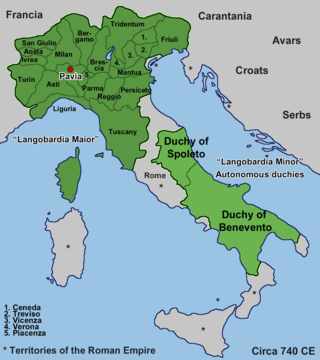
The Kingdom of the Lombards, also known as the Lombard Kingdom and later as the Kingdom of all Italy, was an early medieval state established by the Lombards, a Germanic people, on the Italian Peninsula in the latter part of the 6th century. The king was traditionally elected by the very highest-ranking aristocrats, the dukes, as several attempts to establish a hereditary dynasty failed. The kingdom was subdivided into a varying number of duchies, ruled by semi-autonomous dukes, which were in turn subdivided into gastaldates at the municipal level. The capital of the kingdom and the center of its political life was Pavia in the modern northern Italian region of Lombardy.

The Duchy of Friuli was a Lombard duchy in present-day Friuli, the first to be established after the conquest of the Italian peninsula in 568. It was one of the largest domains in Langobardia Major and an important buffer between the Lombard kingdom and the Slavs, Avars, and the Byzantine Empire. The original chief city in the province was Roman Aquileia, but the Lombard capital of Friuli was Forum Julii, modern Cividale.
Wechtar, a Lombard from Vicenza, was the Duke of Friuli from 666 to 678. He took control of Friuli at the command of King Grimoald following the rebellion of Lupus and Arnefrit and the invasion of the Avars. According to Paul the Deacon, he was a mild and fair ruler.

The Duchy of Tridentum (Trent) was an autonomous Lombard duchy, established by Euin during the Lombard interregnum of 574–584 that followed the assassination of the Lombard leader Alboin. The stronghold of Euin's territory was the Roman city of Tridentum in the upper valley of the Adige, in the foothills of the Alps in northern Italy, where the duchy formed one of the marches of the Lombard Kingdom of Italy. There he shared power with the bishop, who was nominally subject to the Patriarch of Aquileia. In 574–75, Lombard raiding parties pillaged the valley of the Rhône, incurring retaliatory raids into the duchy by Austrasian Franks, who had seized control of the mountain passes leading into the kingdom of Burgundy. Euin was at the head of the army loyal to Authari that went into the territory of the duke of Friuli in Istria, c 589, and he was sent by Agilulf to make peace with the Franks his neighbors, in 591. After Euin's death c 595, Agilulf installed Gaidoald, who was a Catholic, rather than an Arian Christian. After some friction between king and duke, they were reconciled in 600. The separate Lombard duchy of Brescia was united with Tridentum in the person of Alagis, a fervent Arian and opponent of the Lombard king, Perctarit, who was killed in the battle of Cornate d'Adda (688).
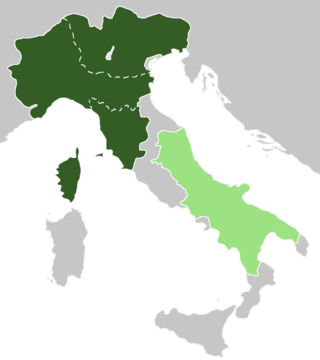
Austria was, according to the early medieval geographical classification, the eastern portion of Langobardia Major, the north-central part of the Lombard Kingdom, extended from the Adda to Friuli and opposite to Neustria. The partition had not only been territorial, but also implied significant cultural and political differences.
Among the Lombards, the duke or dux was the man who acted as political and military commander of a set of "military families", irrespective of any territorial appropriation.
The Historia Langobardorum codicis Gothani, also called the Chronicon Gothanum, is a history of the Lombard people written at and for the court of King Pippin of Italy between the years 806 and 810. It is preserved in the 10th/11th century Codex Gothanus 84, from which its conventional Latin titles are derived; The chronicle is not titled in the manuscript. The text is ideologically pro-Carolingian, and among its sources are Isidore of Seville and possibly Jerome.
Theodota was a Byzantine noblewoman, most notable for her association with the Lombard king Cunipert (688-700). The Plutei of Theodota are named after her.









